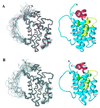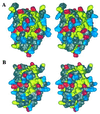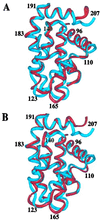Solution structure of the antiapoptotic protein bcl-2
- PMID: 11248023
- PMCID: PMC30598
- DOI: 10.1073/pnas.041619798
Solution structure of the antiapoptotic protein bcl-2
Abstract
The structures of two isoforms of Bcl-2 that differ by two amino acids have been determined by NMR spectroscopy. Because wild-type Bcl-2 behaved poorly in solution, the structures were determined by using Bcl-2/Bcl-x(L) chimeras in which part of the putative unstructured loop of Bcl-2 was replaced with a shortened loop from Bcl-x(L). These chimeric proteins have a low pI compared with the wild-type protein and are soluble. The structures of the two Bcl-2 isoforms consist of 6 alpha-helices with a hydrophobic groove on the surface similar to that observed for the homologous protein, Bcl-x(L). Comparison of the Bcl-2 structures to that of Bcl-x(L) shows that although the overall fold is the same, there are differences in the structural topology and electrostatic potential of the binding groove. Although the structures of the two isoforms of Bcl-2 are virtually identical, differences were observed in the ability of the proteins to bind to a 25-residue peptide from the proapoptotic Bad protein and a 16-residue peptide from the proapoptotic Bak protein. These results suggest that there are subtle differences in the hydrophobic binding groove in Bcl-2 that may translate into differences in antiapoptotic activity for the two isoforms.
Figures






References
MeSH terms
Substances
Associated data
- Actions
- Actions
LinkOut - more resources
Full Text Sources
Other Literature Sources
Molecular Biology Databases
Research Materials
Miscellaneous

